Journalism has been represented and celebrated throughout the history of cinema as far back as 1941’s Citizen Kane right up to 2016 when Spotlight won the Academy Award for Best Picture. Hollywood has been kind in depicting journalists as noble crusading truth-tellers, even when journalism was coming under attack from politicians and their supporters. For this list l wanted to look back on the movies I had admired, which depicted this curious yet fascinating profession. Some titles here were shown to me in journalism school, and while many I had already seen, I still appreciated and even saw through a fresh viewpoint. The titles here go back as far as 1960 and the most recent title as mentioned is from 2015. Both were Oscar-nominated and celebrated upon their release, which shows that the stories of simple people working in a remarkable occupation continue to be of interest and curiosity to audiences.
All the President’s Men (1976)
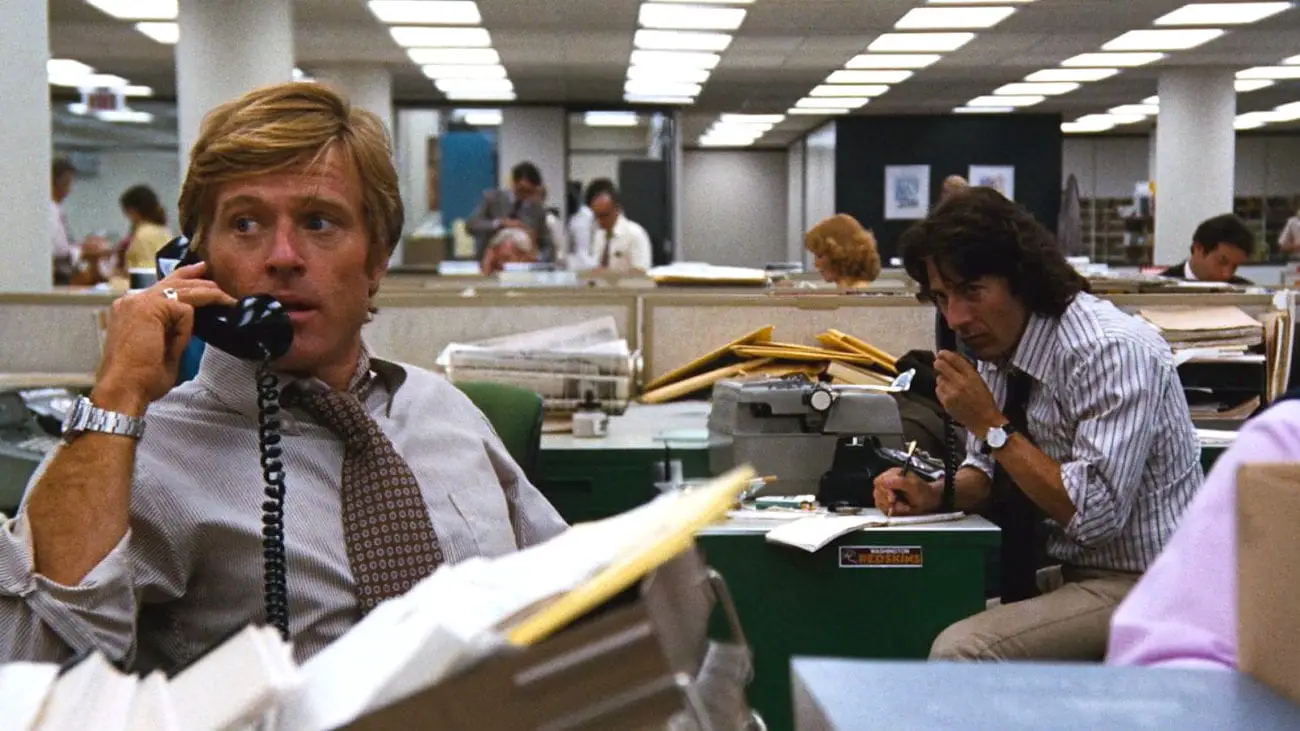
There probably isn’t a journalism school in the world that hasn’t been shown this movie early on in the course. I’m not sure if instructors show this movie to frighten students away from the profession and if so, I can say it didn’t work on my class. In fact it invigorated us even more to stick with it. Yes, journalist’s are often saddled with the “cat in the tree” and “town blueberry festival” assignments early on but sometimes, just sometimes, good journalists and journalism can change the world and even change the course of history such as the subjects of Alan J. Pakula’s All the President’s Men..
Men tells the story of two Washington Post reporters, the now legendary Carl Bernstein (Dustin Hoffman) and Bob Woodward (Robert Redford), who through tips, exhaustive interviewing and investigating brought down a presidency. In the years since, neither one of these real-life reporters let up (Woodward wrote not one, but two exposés of life in the Trump administration) yet how they brought down Nixon’s tenure is now legend. Sure, some things about this movie are very dated (spending long hours, days and weeks sifting through files and documents looking for a clue or lead when the same thing can be done in five seconds today with Google) not to mention Bernstein’s very blatant flirting with a source would not fly anywhere today, but what matters is how much this film got right. Including anyone who’s ever dealt with an editor in a newsroom and knows that feeling of unease when you’re sitting there waiting to hear if your tireless work is “good” or “shit.” Lucky for Woodward and Bernstein, their editor went the former and not the latter.
Almost Famous (2000)
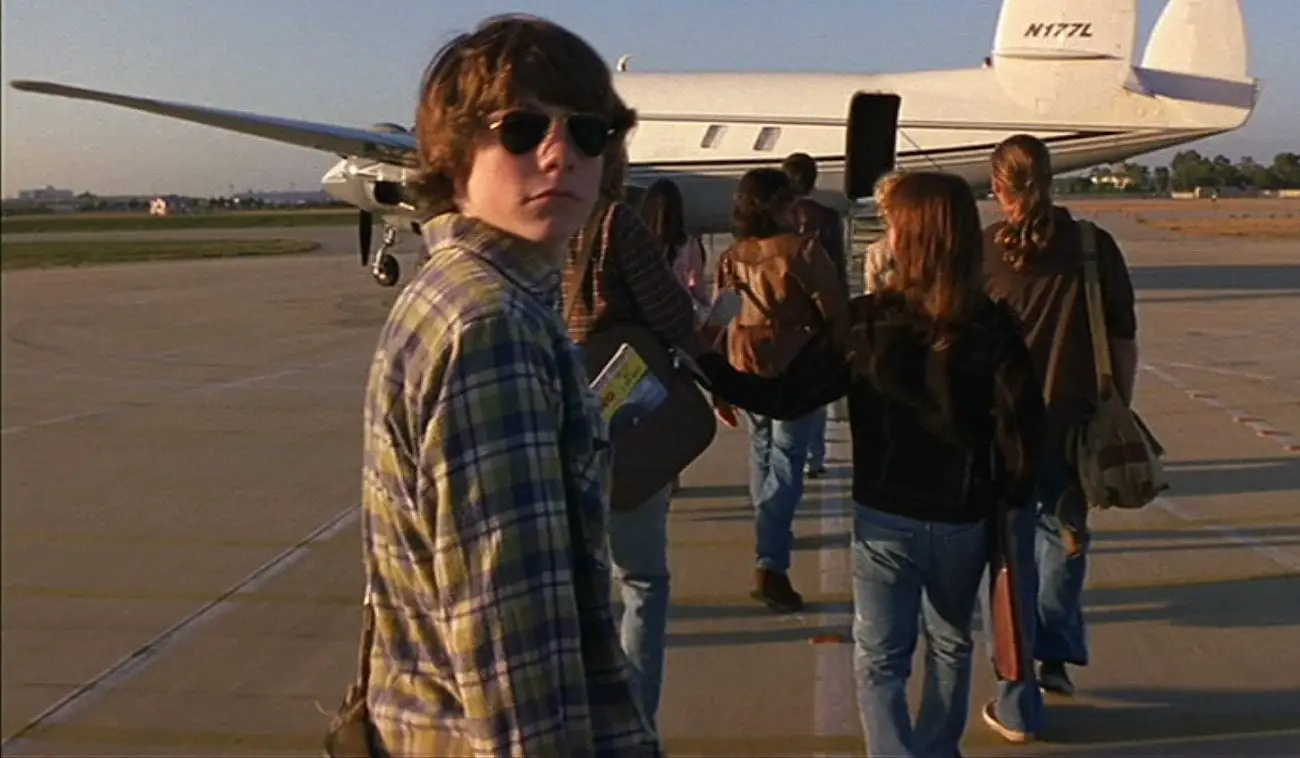
Cameron Crowe began his career as a young reporter for Rolling Stone interviewing such acts as The Allman Brothers, The Eagles, Bob Dylan, Tom Petty, Linda Ronstadt, Elton John, David Bowie and Led Zeppelin. He had no formal journalism training, just a profound love for rock music and the people who made it. He was 15-years-old when RS editor Ben Fong-Torres sent him on the road and after a few years Crowe turned his attention to screenplay writing with his first film Fast Times at Ridgemont High released in 1982. With the success of Jerry Maguire in 1996, Crowe’s next movie would be about his years as a young RS writer and how they shaped his life.
Almost Famous (filmed during the summer of 1999) stars Patrick Fugit as William, a young reporter assigned by Fong-Torres to cover the fast rising band Stillwater on the road and that he’s not to “make friends” with them. Of course it isn’t long before young William is seduced by the lifestyle and falls for “Band-Aid” Penny Lane (Kate Hudson) who adds to the romanticism of it all.
Anybody who’s seen Almost Famous counts the “Tiny Dancer” scene as of course a standout, but the moment that hits it out of the park is when William tells Penny he needs to go home, to which she informs him that he is home—not physically on the tour bus sitting amongst shaggy-haired rockers, but his home is in telling stories. At first he thinks he’s telling Stillwater’s story but he realizes the story he’s telling is his own. With Almost Famous Crowe did something most teenagers dream about. He made a movie about the best time of his life.
Shattered Glass (2003)

All the President’s Men might be the ultimate example of how to operate as a journalist (save for that very obvious flirting with a source) but this title here might be the one that falls into the category of don’t do this in the field. Any of it! And for good reason. Shattered Glass, written and directed by Billy Ray (Richard Jewel), tells the story of D.C. journalist Stephen Glass, a young rising star reporter whose work appeared in Rolling Stone, George, and primarily The New Republic, a magazine famously read by many of Washington’s top politicos. Glass had authored over two dozen pieces for the magazine mostly during the Bill Clinton years (before Wikipedia existed). His pieces were captivating, entertaining, and colorful. They were also mostly fabricated in whole or in parts. Even today, over 20 years later, when someone says the phrase “disgraced journalist”, the name which comes to mind is Stephen Glass.
Perhaps it was his talent for writing compelling stories that explains why Glass went so long without raising suspicion, or it was his eager-to-please nature among his co-workers (not to mention his skill at utilizing emotional manipulation when the occasion called for it) but in the end, it was two other rival journalists and the rise of the internet which led to Glass’s downfall.
Shattered Glass features a terrific cast of actors with Hayden Christensen and Peter Sarsgarrd as the two standouts. Also great are Chloë Sevigny, Steve Zahn and Rosario Dawson (whose character disappears way too early) and in the spirit of true journalism Shattered Glass certainly gets the what, when, where and who aspects correct but as to the why, perhaps it’s best to read Buzz Bissinger’s Vanity Fair piece to find that out. It’s a story that perhaps even Glass would later find too incredible to believe.
Spotlight (2015)
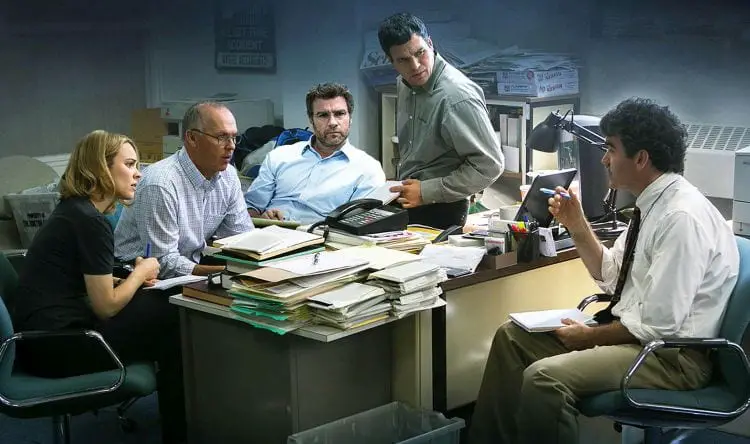
What makes Spotlight great so is how dead-on the little details are; the warming up the cold pizza in the staff room microwave, the way Rachel McAdams’s character jots her notes down in a little paper pad (today it would be in an iPhone), the way Mark Ruffalo’s character pounds the pavement rather than just Googling to find out something (this was 2001, after all) and the way a newsroom full of professionals work together in one setting instead of over Zoom.
Tom McCarthy’s Oscar-winning film is a movie about the small details as its main characters, the investigative “spotlight” team of The Boston Globe work together on a big story. That bigger story was uncovering sexual abuse within Boston’s Roman Catholic church which was only brought forth by all the little circumstances and details leading up to breaking the story. The movie also does an admirable job by giving interview subjects ample screen time, something a lot of journalism movies don’t do but the makers behind Spotlight understand without these individuals, reporters have no story to write and the bad guys will keep on getting away with it.
The End of the Tour (2015)
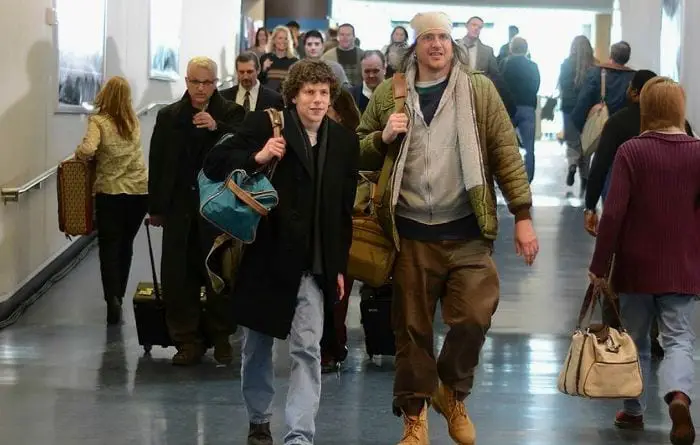
The End of the Tour is 2015’s second-best movie about journalists but this one fell under Spotlight’s mighty shadow and only due to it showing up on several streaming services within the past year are people discovering it. I like to think of this one as a dramatic Planes, Trains, and Automobiles; a story about two very different people forced to spend a week together traveling across the country by plane and automobile. Sadly there is no train, but the comparison still works.
In this true story based on the book Although of Course You End Up Becoming Yourself, Jesse Eisenberg plays Rolling Stone reporter David Lipsky who is intrigued by the buzz surrounding a brilliant novel named Infinite Jest by writer David Foster Wallace (Jason Segal). With the approval of RS‘s editors, Lipsky tracks down Wallace just as the author is about to embark on a week-long publicity tour during the winter of 1996. The two writers don’t exactly love each other on first meeting yet bit-by-bit, the chill begins to thaw between them—until it becomes unclear just who exactly is interviewing whom as the tour goes on.
The End of the Tour is not big on plot as a great deal of the movie takes place inside Wallace’s modest home, and like most movies on this list, is very dialogue heavy. The two leads do an admirable job playing real life individuals trying to figure each other out. Both actors are great to watch and if anything, demonstrates that acclaimed writers and journalists are just as messed up as everybody else.
The Insider (1999)

This is my favorite movie about journalists and journalism ever for reasons too many to mention, but mainly because its story is too incredible to believe. If there is such a thing as an epic journalism movie, then Michael Mann’s The Insider is it. It is huge in terms of reach, talent, meaning, and exploration of human beings. It’s also filmed in widescreen 2:35:1 instead of the more intimate 1:85:1 as most titles here are. It’s even the longest title on this list in terms of running time (158 minutes), with not a scene wasted.
Back in the late 80’s to mid-90s there were a few of what I liked to call “men in suit” movies (not to be confused with the Men In Black series), these movies consisted of titles such as Wall Street, Glengarry Glen Ross, Presumed Innocent and to an extent, even Reservoir Dogs. They were movies which consisted primarily of men wearing suits and ties yelling at each other in close quarters throughout. The Insider is the ultimate “men in suit” movie which featured such characters sitting across from each other in hotel rooms, cars, courtrooms, corporate boardrooms, offices and even school hallways. And when the two main characters doing the the yelling are Al Pacino and Russell Crowe (playing real life individuals 60 Minutes producer Lowell Bergman and former Brown and Williamson scientist Jeffrey Wigand) it’s impossible to not be riveted.
The Insider is based on the 1996 Vanity Fair article “The Man Who Knew Too Much” by Marie Brenner which tells the story of Wigand going on the record to 60 minutes about the addictive ingredients their companies add to cigarettes. Despite threats from his former employer, Wigand tells his story to CBS, only to learn the network is having cold feet about airing the story. The Insider becomes the story of two men at war with everybody whose only goal is to tell this story to the public. The Insider showcases one of the aspects of journalism not usually seen in movies: finding a home for a story that has been worked on with blood, sweat and tears. As this movie shows, it’s not always that easy but when it does get out there after the fights, the struggles, the sacrifices and the fear, there’s no feeling like it.
The Paper (1994)
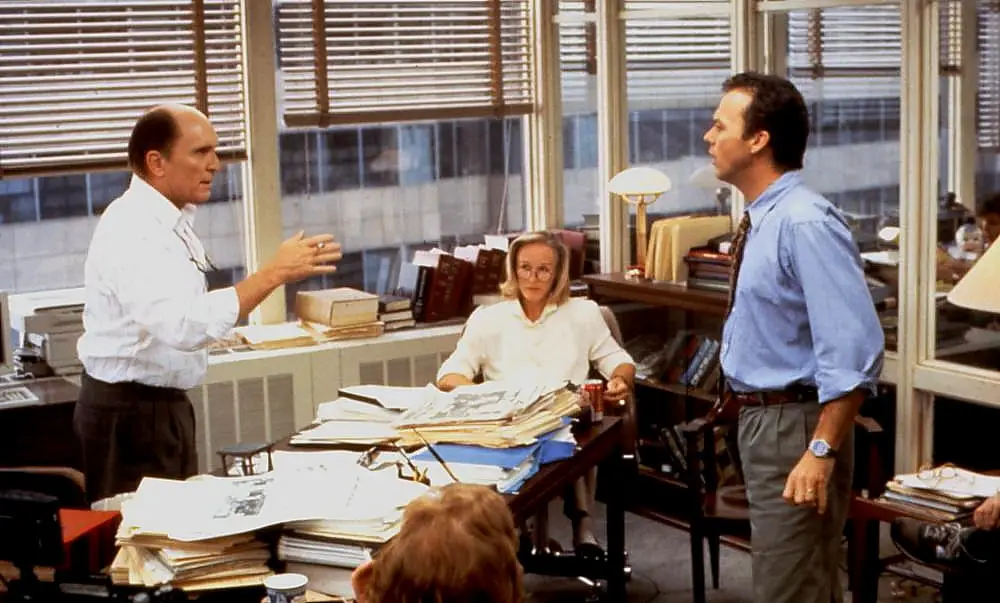
This might be the only title on here not based on a true story but still made with genuine appreciation and love for the profession. It’s also the only comedy on the list and the reason it works is because yes, despite some of the heavy reporting journalists often do, sometimes they laugh as well. Ron Howard’s The Paper (written by Stephen and David Koepp of Jurassic Park and Carlito’s Way) takes place over a single 24-hour period in the early 90s, again back before Google and Smartphones. Michael Keaton stars as Henry Hackett, editor of a New York newspaper, The New York Sun that’s not quite up to par as The New York Times but less sleazy than The Post. At one point he jokingly suggests the headline “Donald Trump jumps off a building…lands on Madonna.” for the front page. If only he knew in 1993 what we know now.
The big news story in the city that day concerns the arrest of two black teenagers accused of murdering two slain Italian men late one night. The city is in a rush to judge them guilty but Henry has a gut feeling there’s more to it and with staff meetings, a pregnant wife (Marisa Tomei) he’s worried about, a job interview and an office full of people nagging at him every minute, Henry will need a vending machine full of Coke to get through the day.
The Paper crams a lot into its two hour running time and Howard keeps the action moving (often through the use of hand-held cameras) swiftly even with an all-star cast (Robert Duvall, Glenn Close, Randy Quaid, Jason Alexander) each given their moments to shine. The tone may be lighter in this movie but the end result is the same as the others; to get the story right, feel good about it, get ready to do it all again in the next 24 hours.
La Dolce Vita (1960)
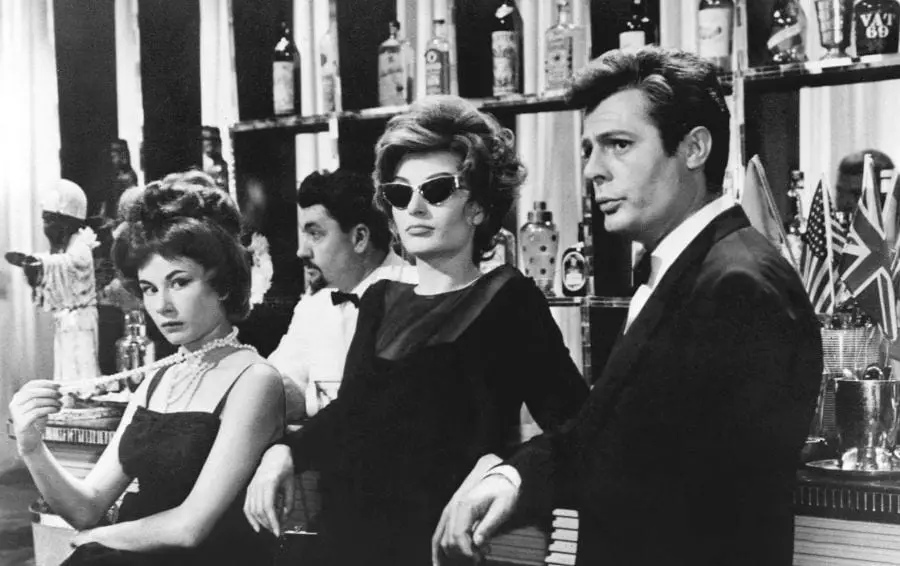
The journalist featured in Federico Fellini’s La Dolce Vita, Marcello Rubini (Marcello Mastroianni) is unlike any other journalist featured in the films on this list. He doesn’t work in cramped cubicles in rumpled clothes drinking stale coffee. He works in trendy clubs, sips tasteful wine, dons his classiest tuxedo on assignments and frolics with Rome’s most beautiful women during the night, retreating back inside once dawn breaks only to do it all again once the sun goes down. Marcello is a gossip journalist writing for a disreputable Italian publication yet he’s likable (and suave enough) to be corralled into spending the night with one of society’s upper-class females.
Marcello isn’t all about dirt and scandal, however. He has literary aspirations of becoming a great writer, yet dirt and scandal and sensationalism pay the bills, and over the course of La Dolce Vita, the lines between literary tastefulness and sleazy debauchery become clouded in his mind. Every once in a while, a reminder of his strive for legitimacy and purity crosses his path, only to be corrupted again by the vampires who prowl the night and Marcello wastes away his ambition lusting after women he can’t have and abandons his loftier goals of respectability out of fear of ridicule. In the end, he chooses to sleepwalk aimlessly through life, numbing himself to the failure he’s content to become.
La Dolce Vita is now celebrated as a landmark film even if it’s main character slinks away at the dawn of a new day. In fact, the term “paparazzi” came about as a result of this film. It’s a term still used to describe night dwellers who feast on sin and celebrities who party during the night. Fellini wasn’t the first or last to blend journalism and film but his imprint remains large in both worlds.
These are eight of my favorite movies about journalism and I’m sure there could be another list made featuring titles such as The Pelican Brief, Absence of Malice, Salvador and others. It’ll be interesting to see where journalism goes and how it’s depicted in film in the next few years but while technology may change, the way reporters unravel the story will not.


